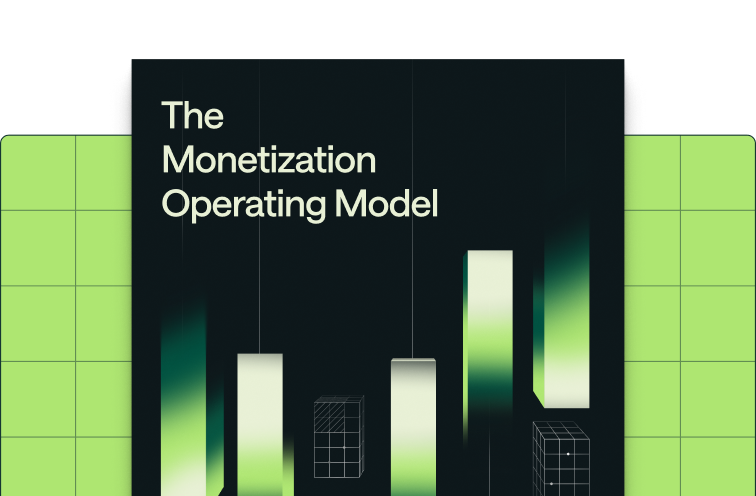Share
Most SaaS pricing strategies focus on packaging: building the right plans, fine-tuning per-seat price points between plans, or deciding what features go where.
Companies spend months perfecting their pricing pages.
But in the Value Era, the biggest constraint is infrastructure.
We've entered the Value Era, where software completes tasks autonomously rather than just supports human work. AI processes 50 emails for one customer and 5,000 for another. Document tools handle 100 pages for startups and 100,000 for enterprises.
This means companies need to be able to price outcomes and results, not just access. When the same feature delivers different value across customers, pricing must reflect what customers actually get done.
Static pricing plans can't capture AI and usage value.
The problem is — not all companies have the billing infrastructure to adapt.
{{widget-monetization-whitepaper}}Why rigid billing infrastructure has become the bottleneck
Companies in the Value Era need multiple pricing models. But legacy billing systems force binary choices since they can't handle this complexity.
The variance in value that comes with AI-enabled software requires flexible pricing options. Meaning companies need seat-based subscriptions for predictable access features and usage-based pricing for consumption features. Many need hybrid models that combine both approaches within a single contract.
Legacy billing systems can't support this flexibility.
They were built for single pricing models, either pure subscription or pure usage-based, with hardcoded logic that requires engineering work for every change. When companies try to layer new pricing models onto old infrastructure, they end up with manual processes, disconnected systems, and operational chaos.
The infrastructure gap creates a bottleneck. Product teams ship new features weekly, but implementing pricing for those features requires months of custom development, cross-team coordination, and manual workarounds.
Pricing infrastructure enables dynamic pricing
The solution is treating pricing as infrastructure: flexible, modular systems that scale with your product and evolve as fast as your features.
Modern pricing infrastructure is more than just better billing software. It's also systems that enable continuous iteration, support multiple pricing models simultaneously, and connect usage measurement directly to revenue capture.
From rigid plans to dynamic systems
Traditional pricing generally operates through static plans created annually and managed through spreadsheets. Dynamic pricing systems start with modular components that can be configured, combined, and updated independently.
Usage metrics, pricing rules, customer segments, and billing logic become building blocks that product and operations teams can arrange without engineering work.
Modern pricing infrastructure has four core characteristics:
- Modular platform: Build pricing components that can be configured without code. Usage tiers, volume discounts, commitment credits, and outcome bonuses work independently but connect seamlessly.
- Continuous iteration: Test pricing like you test features with fast cycles and data-driven decisions. Deploy changes in minutes instead of months.
- Automated deployment: Roll out pricing updates without engineering sprints. Changes propagate automatically across billing systems, sales tools, and customer dashboards.
- Data-driven visibility: Give customers real-time insights into usage and spend with predictive billing and spend controls that prevent bill shock.
These characteristics transform pricing from a rigid annual exercise into a dynamic system that evolves with your product.
Instead of choosing between subscription or usage-based models, companies can combine both approaches and adjust pricing strategies based on real customer behavior and market feedback.
The pricing infrastructure stack
Modern pricing infrastructure has four core layers:
- Measurement layer: Real-time tracking of usage, outcomes, and value delivery tied directly to customer experience. Every API call, workflow completion, or outcome achievement gets captured and attributed to the right customer and billing period.
- Logic layer: Configurable pricing rules that can be mixed, matched, and updated without code changes. Rate tiers, volume discounts, and promotional credits become configuration settings instead of hardcoded business logic.
- Experience layer: Customer-facing dashboards and spend controls that build trust through transparency. Customers see exactly what they're using as it happens and can set spending limits.
- Integration layer: Seamless connection between product usage, billing systems, CRM, internal BI, and financial reporting. Every team works from the same source of truth.
Packaging doesn't disappear — it becomes part of the system. Instead of static bundles updated once a year, you define modular building blocks that can be bundled, priced, and changed without code.
How to build a pricing system that scales with product velocity
Successfully implementing pricing infrastructure requires systematic coordination across four phases that build incrementally without disrupting existing operations.
Phase 1: instrument value delivery
Define measurable value units that connect to customer outcomes: API calls that power applications, workflows that save manual work, and documents processed automatically. Implement usage tracking infrastructure that captures value in real-time with accurate metadata: customer ID, services consumed, usage type, volume consumed, and timestamp.
Ensure data accuracy and consistency across product, billing, and customer-facing systems. Usage data that powers customer dashboards should match exactly what appears on invoices.
Phase 2: build modular pricing logic
Create pricing components that work independently but connect seamlessly. Usage tiers, commitment discounts, and regional adjustments should be configuration settings that business teams can modify without engineering involvement.
Separate pricing rules from product code to enable rapid experimentation. Rate changes and new promotional pricing should deploy in minutes with version control and approval workflows that maintain governance without slowing iteration.
Phase 3: enable customer transparency and control
Build usage dashboards and spend visibility into the core product experience. Customers should see consumption patterns, spending trends, and remaining credits without leaving your application. Provide predictive billing and spend controls with spending limits and notifications.
Leading companies treat billing as a strategic data source that reveals expansion opportunities, churn risks, and product optimization insights through usage patterns.
Phase 4: connect cross-functional operations
Integrate usage and spend data with CRM, billing, and revenue recognition systems so sales teams see customer consumption patterns, customer success teams monitor usage health scores, and finance teams receive automated usage-based revenue data.
Enable real-time forecasting and margin analysis based on actual usage patterns. Create automated workflows that flag high usage customers for expansion conversations and trigger interventions for declining usage.
Success metrics: Track product team velocity (time from pricing concept to market test), business impact (revenue expansion from value-aligned pricing models), and operational efficiency (reduction in billing-related support tickets).
The competitive divide: infrastructure winners vs. legacy operators
Companies are splitting into two categories based on their pricing infrastructure: those who can adapt pricing in real-time (the winners) and those stuck with manual, months-long processes (the stragglers).
This gap is widening as AI and usage-based models accelerate the need for pricing agility.
The winners
Companies like OpenAI treat monetization infrastructure as a core competitive advantage. They respond to market changes in hours instead of quarters, adjust pricing faster than competitors, and configure new packaging models instantly when customers request them.
These companies treat pricing as a product requiring ongoing iteration, invest in systems enabling rapid experimentation without operational risk, and measure pricing performance with the same rigor as product metrics. The infrastructure enables strategic capabilities that compound: entering new market segments by creating custom pricing models in days, responding to competitive threats by adjusting rates instantly, and capturing expansion revenue as it happens.
The stragglers
Legacy operators manage Value Era complexity through rigid pricing systems and manual processes. They recognize the need for pricing evolution but struggle with execution because every change breaks something, and every experiment requires months of coordination.
They follow predictable patterns: recognizing pricing needs during annual planning, spending quarters evaluating solutions, and implementing changes slowly to avoid disrupting operations. By the time new pricing launches, market conditions have changed. The operational constraints create strategic constraints — they can't respond to competitive moves, miss market opportunities, and leave expansion revenue on the table.
The acceleration effect
As AI and usage-based models proliferate, operational gaps become strategic gaps that compound over time. Companies with modern infrastructure experiment with AI pricing models and hybrid monetization strategies while competitors struggle with basic operational challenges.
Market dynamics amplify the effect. Customers increasingly expect transparent, usage-aligned pricing and prefer working with companies that can adapt pricing to their specific needs and provide visibility and control over spending.
Monetization infrastructure as strategic advantage
The shift from rigid plans to flexible pricing represents more than operational improvement. When value delivery becomes dynamic and continuous, flexible pricing becomes the foundation for sustainable competitive advantage.
Companies must decide whether to view pricing complexity as an operational burden or a competitive differentiator. The winners are choosing differentiation, building systems that turn pricing agility into a systematic growth engine.
AI acceleration means the window for building modern monetization infrastructure is narrowing as Value Era native competitors gain market share. These companies launch with usage-based models from day one without legacy subscription systems to migrate away from. They move faster because they're not fighting their own infrastructure.
The transformation is from static plan decisions made annually to dynamic pricing systems that evolve continuously. Companies that make this shift now will capture more value from their products, serve more customer segments effectively, and grow faster than those constrained by rigid systems.
{{widget-monetization-whitepaper}}










